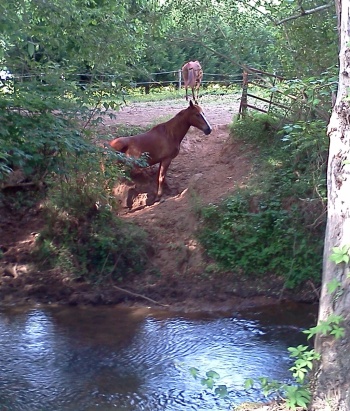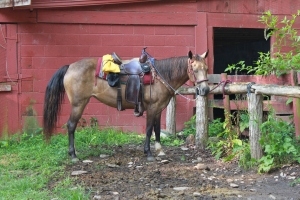By Ilka Parent
Shortly after I completed my first training with the Equine Assisted Growth and Learning Association – when I was in the “un-training” mind-frame, so to speak, I wanted to see if this “stuff” really worked and how it might be applicable in my work. For that, I needed a volunteer who would trust me enough to give it a try.
 After several inquiries a lady I know quite well volunteered. A few years ago, she had been diagnosed with breast cancer. She had undergone surgery, chemo and 6 weeks of daily radiation. The exertions of this medical treatment were quite visible in her face and body – she had aged quite a bit during that timeframe.
After several inquiries a lady I know quite well volunteered. A few years ago, she had been diagnosed with breast cancer. She had undergone surgery, chemo and 6 weeks of daily radiation. The exertions of this medical treatment were quite visible in her face and body – she had aged quite a bit during that timeframe.
My equine specialist – at that time, it was still Dany Denehan – and I asked her to give us a subject to work on. Here I need to clearly state that overall, it is not advisable to work therapeutically with friends or relatives. It is not ethical and many a boundary is overstepped if one chooses to do so. Therefore, we ultimately agreed to have the ensuing interaction between this woman and the horses under the theme of “self exploration”.
We asked this woman to go into the pasture with us, and to take one or more horses – as many as she liked – to a spot that was safe to her. That is all we said.
The woman looked at us and asked what we meant by that. We then – just like I had learned (un-learned it…) during my training, we did not answer but rather walked – backwards – slowly away from this woman towards the fence.

The Minds-n-Motion horse team in North Carolina, with the full-bred Arabian on the right.
The woman stood there for a moment. The horses that we were using for this session, were a distance away, grazing calmly. After a while – which seemed to be an eternity for me! – the woman slowly moved towards the horses. Those continued to graze, with the only difference that they slowly turned away from the woman – or did they turn away from us, standing at the fence? After a few moments the woman turned around, and called to us: “I can’t move him. Are we done now? What shall I do?”
We did not respond to this question. That’s what I had learned in the training. The woman appeared frustrated over our silence. She turned around and stood next to the full bred Arabian.
The horses continued to graze. At one point, the larger one started to move away from the woman and the smaller horse, towards the other end of the pasture. The full bred Arabian stopped grazing, but remained standing next to the woman.
And there they stood …
… and stood.
At one point, my inner “alarm bells” were going off. As a therapist, I am used to conversations and to keeping the exchange flowing between the client and myself. Even though silence is important and often times encouraged, with the pressures of HMO I was used to keeping things going. Even though we could only see the back of this woman – she was rather far away – it appeared that she was crying. This situation was becoming rather difficult for me. The EAGALA method proclaims that the main interaction is to be between client and the horse(s). That talking and discussing is to be kept at a minimum. However – in this case – there didn’t appear to be anything going on!
Dany kept me back. I wanted to approach the woman and do a so-called “check in”. It was hot – North Carolina summer! – and I was afraid that the woman was not only frustrated, but also needed help due to feeling overwhelmed in this situation, or that she might think bad of this method – possibly talk bad about it in our neighborhood (about me as well?), or possibly have this experience reflect on our friendship. In my quiet exchange with Dany I became aware, that all those were nothing but my own concerns and worries that I was possibly projecting on this woman. Therefore, we continued to wait and simply observe the body language of the full-bred Arab and the Woman. The second horse by now had reached the end of the pasture and was no longer in our sight.
We completed the entire 45 minutes – that we had set out to do – just like this. After those 45 minutes, we did approach the woman, with the request to do a “check in”. The woman turned around to us. She had traces of dried tears on her cheeks, but looked soft, relaxed and seemed to move with much more ease than before.
Dany asked the initial question: “How did that go for you?”
The answer, to this day, built the cornerstone of my “quest” with EAGALA. An answer that forever changed the way I work with clients.
The woman told us – without hesitation – that initially she had focused on us, who had not provided her with help in this seemingly impossible situation. She had felt fear of approaching these big animals. When she had hesitantly attempted to move them, she quickly gave up at her unsuccessful attempts. She shared with us that she had felt great anger when we continued to not respond to her pleas for help. She described how she felt the tears – tear of anger, rage and helplessness – run down her cheeks. However, she did not want to disclose those feelings to us, thus had turned away, showing us only her back. At some point – she looked at us and said that she didn’t even know when this had happened – at some point she became aware that the full-bred Arabian had stopped grazing and simply stood next to her. She recounted how she had then focused on the animal’s breathing, his rather unusual smell, the swishing of his tail, and how her tears stopped flowing. She recounted how then her thoughts started to drift – how she was reminded of her struggle with her cancer, her fight for her life. She had felt the same way during that fight: rage, anger, and helplessness. She also had asked for help, and had not received it. She had also cried then, tears of rage and fear and loss of courage. And she was reminded how then – in her struggles – she had become quiet as well, becoming aware of who she was and still is.
She continued to tell us, all the while standing next to this horse, touching it, letting her fingers run over its body, that she had become aware that she was not alone. That his little horse – despite being a horse – simply had remained next to her throughout these feelings, and continued to stand right by her side. And she told us that she had started to feel courage and free.
Dany and I stood there, listening to this woman. I started to feel humble – humility and respect for this woman across from us, who so openly shared what she had experienced – and humility due to my arrogance and assumptions earlier, as I had wanted to interfere and interpose myself into this process in order to “rescue” this woman – or avoid a bad reputation?
And thus concluded our session.
Now you might ask yourself if this was all due to the so-called “magic of the horse”. One can not argue that there is always a therapeutic effect when interacting with animals. Lower blood pressure, more regular breathing, overall optimism – all those are known and well-studied effects with clinical significance.
But the EAGALA method does not rely on that. It is a side effect that can be observed throughout the sessions. The essential part of our work (and here I could start talking and talking about the method for quite a long time) – but the essential part of our work is that the focus is NOT on the talking, discussing, verbally pulling apart the experience and explaining it (or possibly explaining why our clients felt the way they felt) – but rather on the client ACTING and DOING with the horses. The horses are simply a means to us – the team standing by the fence, observing what is happening – to see the reflection of what is possibly going on in the client.
The horse, when it stopped grazing – around that time the woman stopped focusing on what was NOT (in her life, going well, … any of those negatives) – simply put “the burden” – to the Here and Now, the togetherness, the company, the letting go of her fears and worries. During this session, we did not need to point out that particular moment – but typically those are the moments we point out in the form of a question. Typically, changes in behavior in the horses indicate some change in behavior in the human, which typically reflect changes in thoughts and attitude.
This meeting occurred many years ago. But just a few months ago, in a conversation with this woman, she shared with me how to this day there are moments when she is reminded of that moment, the moment she realized that she was not alone, and how she still can feel that feeling of togetherness, and how it fills her with calmness and strength to go on. The cancer has not returned, and as she has surpassed the legendary 5 year mark, she now is considered “healed.”
Note: Ilka Parent is a licensed professional counselor and horsewoman, who lives and works in Germany. Minds-n-Motion offers equine assisted psychotherapy and equine assisted learning, partnering with horses to provide authentic feedback about the signals we send out.









